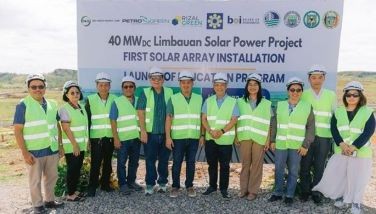Mangan tana! Let's eat!
MANILA, Philippines - Sisig pisngi at balugbug babi from Tindahan sa Kanto, adobong camaru from Cely’s carinderia, batute tugak from 19Copung-copung, and tibuk-tibuk from Susie’s Cuisine — these were just some of the dishes served at the Pamangan Fiestang Kapampangan luncheon buffet hosted by Angeles City Mayor Ed Pamintuan and the Fiestang Kuliat Foundation, which was held at the Culinarium in the Museo ning Angeles in Pampanga. The festival, featuring the best of Kapampangan cuisine, was set for all Sundays of October as part of the month-long Fiestang Kuliat celebration in Angeles City.
Kuliat, which was the name of a type of tree that grew in abundance in the area, was the old name of Angeles City. Fiestang Kuliat is held annually in thanksgiving and celebration of the resiliency of the Kapampangans, who overcame their problems after the Mt. Pinatubo eruption in 1991 and the withdrawal of the US military base in Clark.
“The fiesta celebration was our way of lifting our people’s spirits during those difficult times,” says Mayor Ed, who was the acting mayor at that time. It has since become a tradition.
The people of Angeles take great pride in their rich history and tradition. The Museo ning Angeles, housed in the old municipio that was built in 1922 and recently converted into a museum, showcases the city’s history, lifestyle and culture. The dioramas, which feature the ninay dolls by Patis Pamintuan-Tesoro, dressed in intricate Filipiniana costumes, depict typical Filipino scenes and everyday life.
The Pamintuan Mansion, which belonged to one of the oldest families in Angeles City, is part of a heritage walking tour of the historic district of Sto. Rosario, where the museum is located. Our tour guide, Kim Tinio, relates that President Emilio Aguinaldo stayed in the mansion, where he celebrated the first anniversary of the short-lived Philippine Independence.
The two-story mansion is big, even by today’s standards. The crystal chandeliers, as well as the elaborate details and elements on the walls and ceilings, indicate the strong European influence favored by the wealthy at that time. A spiral staircase leads up to a terrace where you get a view of the neighborhood. You can see the twin bell towers and dome of the Holy Rosary Parish Church, located just across the museo, and somewhere in a distance, the familiar arches of a burger fast-food chain towering over the rusted rooftops of the houses below.
Just a short walk from the museo is the Center for Kapampangan Studies at the Holy Angel University. Established in 2001, the modern, three-story building contains a gallery, museum and library. The Center is doing an excellent job of researching, organizing and compiling facts and artifacts of Kapamapangan culture and heritage. Among its goals is to revive and preserve the endangered Kapampangan language. Its motto is “Become a better Filipino by being a good Kapampangan.”
The crowning glory of Kapampangan culture, arguably, is its cuisine. The entire second floor of the Museo ning Angeles is dedicated to the Culinarium, which showcases “Kapampangan culinary art and science through exhibits and cooking demonstrations.” At the dining table where we enjoyed the sumptuous buffet lunch, Mayor Pamintuan talked about his city and the Kapampangan food that he loves.
The land, traversed by what used to be known as the Rio Grande de la Pampanga or Great Pampanga River, was so fertile that the people did not have any difficulty making things grow. “They had plenty of time left after working in the fields to experiment and invent new dishes in the kitchen,” Mayor Ed relates. Thus, the rich variety in Kapampangan cuisine.
 , the conversation turned to that popular local delicacy, sisig. Angeles City is the birthplace of sisig. It all started with the pregnant women, Mayor Ed relates. Sisig used to be made with just slivers of pork fat floating in plain vinegar, which “infanticipating” women would take to satisfy their craving for something sour. Later, it became a favorite pulutan among the men while drinking beer. One time, Mayor Ed relates, they noticed that the fat in the sisig would turn solid (sebo) easily. So his brother, Benedict, thought of getting their mom’s iron plates, where the sisig could be served sizzling-hot. Thus was born Benedict’s sizzling sisig.
, the conversation turned to that popular local delicacy, sisig. Angeles City is the birthplace of sisig. It all started with the pregnant women, Mayor Ed relates. Sisig used to be made with just slivers of pork fat floating in plain vinegar, which “infanticipating” women would take to satisfy their craving for something sour. Later, it became a favorite pulutan among the men while drinking beer. One time, Mayor Ed relates, they noticed that the fat in the sisig would turn solid (sebo) easily. So his brother, Benedict, thought of getting their mom’s iron plates, where the sisig could be served sizzling-hot. Thus was born Benedict’s sizzling sisig.
Today, you can still enjoy the original sisig taste at Aling Lucing’s. Or you can try preparing it yourself. The mayor’s chief-of-staff, Alex Cauguiran, volunteered his recipe: Boil pig’s cheeks until tender. Air dry, then barbecue. Mince and mix with minced chicken liver and chopped white onions. Season with a pinch of salt and calamansi.
“Make sure you are listening to music by Tchaikovsky or Vivaldi or Beethoven while doing this,” he adds.
But why sweat it when you can simply enjoy your sisig at the Pamangan Fiestang Kapampangan at the Fiestang Kuliat in Angeles City? Also not to be missed is the camuti with gatas damulag (kamote with carabao’s milk) specially prepared by Mayor Ed’s gracious wife, Miniang Pamintuan. It’s surely worth the trip from Manila, which you can now take in just a little over an hour via the North Luzon Expressway. As the official Pampanga Tourism ditty, that’s caught in a last-song syndrome in our head, goes: “Mekeni! Tuki ka! Malaus ka Pampanga!” That is: “Come! Come with us! Welcome to Pampanga!
* * *
For more details and information, call the Museo ning Angeles, tel. no. 045-887-4703, 915-421-6606 or visit www.angelesmuseum.com.



















